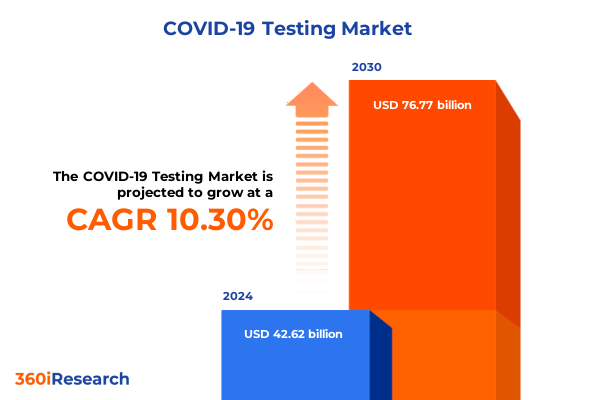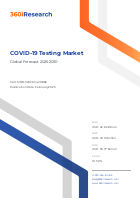The COVID-19 Testing Market size was estimated at USD 42.62 billion in 2024 and expected to reach USD 47.13 billion in 2025, at a CAGR 10.30% to reach USD 76.77 billion by 2030.

Introduction to COVID-19 Testing Dynamics
The COVID-19 pandemic has underscored the critical role of reliable diagnostics in managing public health crises. From the earliest days of the outbreak, testing has served as the first line of defense, enabling health authorities to identify cases quickly, trace contacts effectively, and contain transmission chains. As the virus has evolved, so too have testing methodologies, with innovations ranging from rapid antigen assays to high-sensitivity molecular platforms. In parallel, shifting regulatory frameworks and mounting demands for decentralized testing have driven unprecedented collaboration among manufacturers, laboratories, healthcare providers, and technology firms. This introduction establishes the context for a detailed exploration of the current landscape, highlighting the interplay between technological advances and market dynamics. It lays the groundwork for understanding how strategic decisions in manufacturing, distribution, and adoption will continue to shape global preparedness efforts.
Transformative Shifts in the Testing Landscape
The testing landscape has undergone transformative shifts in response to evolving epidemiological pressures and technological breakthroughs. Rapid antigen assays have transitioned from supplemental tools to frontline diagnostics, thanks to advances in lateral flow and fluorescence immunoassay formats. Simultaneously, molecular testing platforms have leveraged isothermal amplification and RT-PCR enhancements to deliver faster turnaround times without sacrificing sensitivity. Home-based testing has emerged as a mainstream offering, driven by the convergence of self-test kits, telehealth–assisted diagnostics, and over-the-counter rapid antigen solutions. At the point of care, hospital- and pharmacy-based services have integrated digital reporting and remote consultation capabilities to optimize patient management. Underpinning these trends, artificial intelligence integration and predictive analytics are streamlining image recognition, reducing human error, and accelerating result interpretation. Microfluidics and CRISPR technology are opening new frontiers in sample processing and target detection, while next-generation sequencing platforms continue to support variant surveillance. Together, these shifts redefine how stakeholders respond to current and future infectious threats.
Cumulative Impact of United States Tariffs in 2025
In 2025, newly implemented tariffs on imported diagnostic components have reshaped supply chains and cost structures throughout the United States. Manufacturers reliant on overseas reagent suppliers have experienced higher landed costs, prompting adjustments to pricing strategies and sourcing models. As a consequence, several domestic producers have accelerated investments in local manufacturing capacity to mitigate exposure to import duties. At the same time, distributors have revised inventory management approaches, emphasizing buffer stocks and multi-vendor agreements to cushion against potential delays. The tariff regime has also spurred collaborative ventures between domestic and international firms, focusing on co-development of key reagents and modular test kits to streamline cross-border production. In the end, while end users may observe modest price increases for certain assays, these measures are strengthening supply resilience and incentivizing innovation in domestic R&D. The cumulative effect is a more diversified ecosystem, better equipped to withstand future disruptions.
Key Segmentation Insights
A granular view of segmentation reveals distinct performance drivers across test type, mode of testing, sample type, end user, detection time, and technology platform. Antigen diagnostics leverage lateral flow simplicity and fluorescence immunoassay sensitivity, while molecular assays harness isothermal amplification for portability and RT-PCR for high-accuracy applications. Consumer demand has shifted toward self-test kits featuring over-the-counter convenience and rapid antigen responsiveness, often complemented by telehealth-assisted consultations. Meanwhile, point-of-care offerings within hospital settings and pharmacy outlets provide professional oversight and integrated reporting. Sample selection spans blood matrices-capillary blood for finger-prick ease and venous blood for volumetric reliability-alongside nasopharyngeal, oropharyngeal, and saliva swabs tailored to patient comfort and detection requirements. On the end-user front, academic institutions and research centers drive validation studies, diagnostic laboratories execute high-volume assays, and healthcare providers operating in clinics, hospitals, and home care settings support both family-level and individual user requirements. When rapid turnaround emerges as a priority, assays delivering results in under thirty minutes or within an hour dominate; where standard processing prevails, platforms operating within one to six hours, or up to twenty-four hours, maintain relevance. Across all segments, technology platforms such as artificial intelligence integration for image recognition and predictive analytics, CRISPR-based target identification, microfluidics for sample manipulation, and next-generation sequencing for surveillance play pivotal roles in shaping competitive differentiation.
This comprehensive research report categorizes the COVID-19 Testing market into clearly defined segments, providing a detailed analysis of emerging trends and precise revenue forecasts to support strategic decision-making.
- Test Type
- Mode of Testing
- Sample Type
- End User
- Detection Time
- Technology Platform
Key Regional Insights
Regional dynamics underscore the global complexity of the COVID-19 testing market. In the Americas, widespread regulatory harmonization and robust reimbursement frameworks have fueled early adoption of advanced diagnostics across both public and private sectors, with Latin American markets gradually embracing point-of-care and home testing solutions. Meanwhile, Europe, Middle East & Africa present a mosaic of infrastructure readiness: Western European nations maintain rigorous quality standards and centralized laboratory networks, while emerging markets in the Middle East and Africa are pursuing public–private partnerships to expand rural access. In the Asia-Pacific region, local manufacturing hubs in East Asia continue to lead in production capacity, and Southeast Asian governments are integrating testing into broader pandemic resilience strategies. Across all territories, regional innovation clusters are fostering technology transfer and collaborative R&D initiatives, ensuring that testing solutions remain adaptive to variant emergence and shifting clinical protocols.
This comprehensive research report examines key regions that drive the evolution of the COVID-19 Testing market, offering deep insights into regional trends, growth factors, and industry developments that are influencing market performance.
- Americas
- Asia-Pacific
- Europe, Middle East & Africa
Key Companies Insights
Competitive dynamics are shaped by established multinationals and nimble innovators alike, each capitalizing on unique strengths. Abbott Laboratories has leveraged its broad antigen portfolio and strong distribution channels to maintain market leadership, while AccuBioTech Co. Ltd. focuses on modular test formats optimized for decentralized settings. ADT Biotech and AIVD Biotech Inc. drive innovation in CRISPR and isothermal amplification, and Altona Diagnostics GmbH and AMEDA Labordiagnostik GmbH bring German engineering precision to molecular platforms. Becton, Dickinson and Company and Bio-Rad Laboratories, Inc. continue to support high-throughput laboratories, with bioMérieux SA and Cepheid Inc. extending into rapid PCR solutions. Coris BioConcept SPRL enhances niche assay development, whereas Danaher Corporation and F. Hoffmann-La Roche AG focus on integrated diagnostics ecosystems. GenBody America, LLC and Genuine Biosystem Pvt. Ltd. address regional markets with cost-effective rapid tests, and Hologic Inc. advances high-sensitivity assays for clinical laboratories. LAB-CARE DIAGNOSTICS (INDIA) PVT. LTD. and Laboratory Corporation of America Holdings each bolster their service portfolios, while Luminex Corporation and PerkinElmer Inc. drive multiplex and high-content workflows. Quest Diagnostics Inc. and Quidel Corporation deliver seamless reporting and decentralized testing, and SD Biosensor, Inc. and Siemens Healthineers AG emphasize point-of-care automation. Thermo Fisher Scientific Inc. binds the ecosystem together with comprehensive reagent, instrument, and software offerings that support variant surveillance and data analytics.
This comprehensive research report delivers an in-depth overview of the principal market players in the COVID-19 Testing market, evaluating their market share, strategic initiatives, and competitive positioning to illuminate the factors shaping the competitive landscape.
- Abbott Laboratories
- AccuBioTech Co. Ltd.
- ADT Biotech
- AIVD Biotech Inc.
- Altona Diagnostics GmbH
- AMEDA Labordiagnostik GmbH
- Becton, Dickinson and Company
- Bio-Rad Laboratories, Inc.
- bioMérieux SA
- Cepheid Inc.
- Coris BioConcept SPRL
- Danaher Corporation
- F. Hoffmann-La Roche AG
- GenBody America, LLC
- Genuine Biosystem Pvt. Ltd.
- Hologic Inc.
- LAB-CARE DIAGNOSTICS (INDIA) PVT. LTD.
- Laboratory Corporation of America Holdings
- Luminex Corporation
- PerkinElmer Inc.
- Quest Diagnostics Inc.
- Quidel Corporation
- SD Biosensor, Inc.
- Siemens Healthineers AG
- Thermo Fisher Scientific Inc.
Actionable Recommendations for Industry Leaders
Industry leaders must adopt a multifaceted strategy to sustain competitive advantage in an evolving market. Prioritizing investment in home-testing innovation will capture growing consumer demand for convenient, remote diagnostics. Concurrently, strengthening partnerships with telehealth providers and point-of-care networks will ensure seamless integration of results into clinical workflows. Leaders should allocate resources toward artificial intelligence and predictive analytics, elevating diagnostic accuracy and operational efficiency. Expanding domestic manufacturing footprint or securing multi-source supply agreements will mitigate tariff risk and potential shortages. Embracing modular platform architectures will facilitate rapid adaptation to emerging pathogens, while collaborative R&D ventures can accelerate time-to-market for next-generation assays. Finally, engaging with regulatory agencies early in development cycles will streamline approvals and foster trust among end users, ultimately driving sustained adoption and market resilience.
Explore AI-driven insights for the COVID-19 Testing market with ResearchAI on our online platform, providing deeper, data-backed market analysis.
Ask ResearchAI anything
World's First Innovative Al for Market Research
Conclusion
The COVID-19 testing landscape continues to evolve rapidly, driven by technological breakthroughs, shifting regulatory environments, and changing end-user expectations. Stakeholders who align strategic priorities with emerging trends-such as decentralized testing, artificial intelligence integration, and supply chain resilience-will be best positioned to navigate this complex ecosystem. By leveraging segmentation insights, regional dynamics, and competitive intelligence, organizations can identify growth opportunities, optimize resource allocation, and maintain readiness for future public health challenges. The path forward demands proactive collaboration, agile innovation, and a commitment to delivering reliable, accessible diagnostics at scale.
This section provides a structured overview of the report, outlining key chapters and topics covered for easy reference in our COVID-19 Testing market comprehensive research report.
- Preface
- Research Methodology
- Executive Summary
- Market Overview
- Market Dynamics
- Market Insights
- Cumulative Impact of United States Tariffs 2025
- COVID-19 Testing Market, by Test Type
- COVID-19 Testing Market, by Mode of Testing
- COVID-19 Testing Market, by Sample Type
- COVID-19 Testing Market, by End User
- COVID-19 Testing Market, by Detection Time
- COVID-19 Testing Market, by Technology Platform
- Americas COVID-19 Testing Market
- Asia-Pacific COVID-19 Testing Market
- Europe, Middle East & Africa COVID-19 Testing Market
- Competitive Landscape
- ResearchAI
- ResearchStatistics
- ResearchContacts
- ResearchArticles
- Appendix
- List of Figures [Total: 28]
- List of Tables [Total: 765 ]
Call-To-Action to Engage with Ketan Rohom
To access comprehensive analysis, granular segmentation data, and strategic guidance tailored to your organization’s needs, please contact Ketan Rohom, Associate Director, Sales & Marketing. He will provide detailed information on how to secure the full market research report and discuss custom consulting opportunities. Empower your decision-making with actionable insights and position your operations for sustained success in the evolving COVID-19 testing market.

- How big is the COVID-19 Testing Market?
- What is the COVID-19 Testing Market growth?
- When do I get the report?
- In what format does this report get delivered to me?
- How long has 360iResearch been around?
- What if I have a question about your reports?
- Can I share this report with my team?
- Can I use your research in my presentation?




